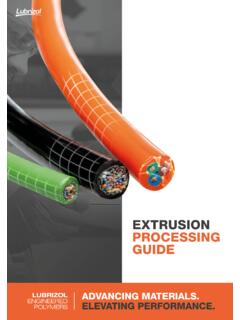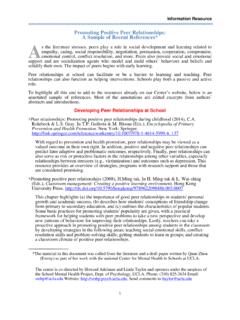Transcription of Injection Molding Guide - Lubrizol
1 POLYMER SOLUTIONSI njection Molding Guide2 Injection Molding Guide IntroductionLifeScience LifeSciences is a business within The Lubrizol Corporation that provides innovative polymer solutions for healthcare products. Among the chemical technologies employed by LifeSciences are thermoplastic polyurethane elastomers (TPUs). LifeSciences TPUs are grouped into several families of products with varying chemical and physical characteristics. They can be readily converted to durable, tough, impact-resistant articles such medical device housings, tubing connectors, etc., on conventional thermoplastic Injection - Molding brochure is intended to provide general guidelines for equipment, procedures and Molding machine conditions that will help the customer obtain the best possible performance from the the Lubrizol LifeSciences of TPU Molding grades.
2 Additional information can be obtained by consulting individual product Technical Data Sheets or by contacting your Lubrizol technical service or sales LifeSciences TPUs are available in both aromatic and aliphatic types. The choice of polyol raw material during manufacture leads to the families of polyester, polyether and polycarbonate grades. Separate literature is available describing detailed properties of the various Molding grades. All of these TPU types have common characteristics as far as basic Molding processing behavior and practices. This Guide covers those general are generally not considered to be crystalline polymers that would be represented by a product like low-density polyethylene (PE). Some of the harder TPU grades (~> 90 Shore A) could be considered semicrystalline. Softer grades 62A 85A can be nearly amorphous they have no definite melting point, but soften gradually on heating.
3 Upon heating and shear mixing within the barrel of the Molding machine, they achieve a viscous fluid state characteristic of a polymer much like low-density , TPUs can be Injection -molded; but from a practical standpoint, many, particularly the softer grades (<70A), are not viable for practical, commercial use. Many of the softer types are nearly amorphous; consequently, Molding would require long setup times. They could be very tacky and stick to the metal mold viscosities suitable for Molding will generally be lower than for typical extrusion processing. Temperatures and shear forces in the Molding machine barrel will be higher than for extrusion. Some of the harder grades will have melt temperatures approaching 450 F/232 C. In general, 450 F/232 C is the onset of TPU thermal degradation. All LifeSciences TPU grades can be Injection -molded below this temperature; individual Technical Data Sheets should be consulted and the recommendations followed.
4 Products should be selected from the LifeSciences Molding product sheets. If a specific set of end-use physical properties is found on on the LifeSciences TPU Extrusion list, it is very likely that the grade can be successfully Injection -molded. Molding conditions can be recommended by Lubrizol technical representatives. The harder thermoplastic polyurethane TPU compounds are specifically designed for fast, easy Injection - Molding of large and small parts. By the nature of their chemical structure, the softer TPU compounds, in the Shore hardness range of 70A to 90A, will take longer to set-up (longer cycle times). Many of the grades are formulated with small amounts of additives to facilitate mold release and prevent blocking of molded parts. All TPU materials produce a very low-viscosity melt compared to other thermoplastics such as polyethylene.
5 Polyethylene PE is a crystalline polymer that still has a relatively high melt viscosity when the crystalline structure melts it. This is due to the high molecular weight (length of polymer chain) of PE. PE can have molecular weights above 1,000,000. In contrast, when a harder ( 50D) TPU melts, it goes to a low melt viscosity rapidly. This is due to the relatively low molecular weight of TPU. TPU will typically have molecular weights in the 100,000 to 200,000 range. Once melted, increasing the melt temperature generally does not reduce the melt viscosity melt viscosity easily fills the most complex mold cavities under low Injection pressure. The low viscosity melt permits the material to flow through small gates and into thin wall sections under low Injection pressure. Low-viscosity melt combined with low Injection pressure minimizes the possibility of producing highly stressed parts.
6 Contents: Introduction ..2 Materials ..2 Equipment Requirements ..3 mold and Part Design ..4 The Molding Operation ..6 Startup Procedure ..9 Troubleshooting Guide ..10 POLYMER SOLUTIONS3 Equipment RequirementsType of MachineAlthough all types of machines have been successfully used, a reciprocating-screw machine is preferred for Molding LifeSciences TPU compounds. A reciprocating-screw machine is capable of producing the most uniform melt, is the most easily controlled, and is capable of the fastest SizeBarrel capacityTo obtain the widest processing latitude and optimum physical properties, an appropriate match of shot size, ( , volume of cavities, runners and sprue) to barrel capacity is very desirable. A shot weight of 60% to 75% of barrel capacity is minimizes melt residence time in the barrel, enabling processing at higher stock temperatures with optimum melt flow while avoiding the optimum match of barrel capacity is not always practical due to clamp requirements or machine availability, shot sizes as low as 30% to 35% may be used with the understanding that the processing latitude of the material may be significantly reduced.
7 Lower stock temperatures mean higher melt viscosity and more resistance to flow. Greater Injection pressures will be needed to fill the part, and molded-in stresses may result. It is likely that these molded-in stresses could adversely affect impact, dimensional stability and other properties of the finished calculating optimum barrel capacity, always consider the specific gravity of the TPU compounds versus the specific gravity of the material for which the machine was rated. Most machines are normally rated for kilograms (ounces), a unit of weight of general-purpose : Given that the specific gravities of TPU compounds and general purpose polystyrene are and , respectively, a kg (60 oz.) barrel rated in general-purpose polystyrene will deliver kg (67 oz.)* of targeted TPU shot weight, including sprue, runners and parts, would then be kg (50 oz.)
8 On this machine.( kg x 75% capacity = kg or 50 oz.)Clamp CapacityA new machine having a minimum clamp force of 300 kg/cm2 to 400 kg/cm2 (2 to 3 tons/square inch) of projected part area, including runners, is recommended. The area of runners in a three-plate mold should be and TipThe screw and tip designs that are designated "general purpose" are best. The compression ratio of most of the general-purpose screws falls between 2:1 and 3:1; this range is the most desirable for melting and homogenizing TPU compounds. The general-purpose tip usually has a 60 included angle and a free-flow mechanism of either ball check or sliding ring type. It is recommended that an antibackflow valve, in good working order, be used when TPU compounds are molded. The low viscosity of their melts makes satisfactory packing-out of the mold cavity very difficult unless an antibackflow device is straight, open nozzle with a full internal taper tip is recommended.
9 A positive-shut-off, antidrool nozzle can be helpful but is not a necessity. If the particular machine or mold design requires a long nozzle or a nozzle extension, it should be well insulated with heater bands so that there are no cold spots. The harder TPU compounds, because of their sharp melting point, can crystallize (set up) if a cold spot exists. The next shot will result in cold slugs of material carried into the cavity along with the hot melt. The longer the cycle required by the particular part, the more troublesome this can become; therefore, the nozzle must be well insulated with heater bands. The bands must extend as close to the tip as type of mold that incorporates good thermoplastic design principles is satisfactory for TPU compounds. Two-plate, three-plate and hot-runner molds have all been used successfully for a variety of large and small parts.
10 For hot-runner molds, as with nozzles, it is important that heaters provide full coverage of the runner system so that cold spots do not exist; the TPU can be maintained in its fluid melt state. The mold must also be adequately cored for cooling because TPU normally requires a relatively cool mold [(10 C to 44 C) (50 F to 110 F)] to produce optimum cycle. The nozzle tips within the hot-runner mold must be well-insulated from the cold side of the mold . Poor insulation and the quick setup characteristics of TPU compounds (primarily the harder grades) can lead to plugged nozzles. A sheet of transite separating the hot and cold sections of the mold is recommended.* kg x = kg (67 oz.) and Part DesignSprue BushingA sprue bushing with a standard 2 included angle, approximately 42mm taper per meter ( in.)







